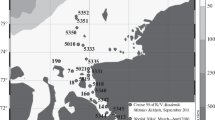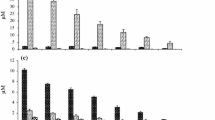Abstract
The growth efficiency of freshwater bacteria was examined in continuous cultures. One series of experiments was carried out using generation times from 50 to 200 hours and aged, normal, and enriched media, all of natural origin. Another series of experiments examined the bacterial growth efficiency during the growth season in eutrophic Frederiksborg Slotssø, in relation to changes in the planktonic communities and to factors controlling the bacterial incorporation of 3H-thymidine. Attachment of bacteria to the inner surfaces of the experimental flasks was examined using various types of bottles, adding glass tubes to the bottles, and measuring 3H-thymidine incorporation and direct cell counts of attached and free-living bacteria. Attachment of bacteria varied, and in one example up to 36% of the thymidine incorporation was by attached bacteria after 4 days. It was calculated that 36% of attached bacteria caused an underestimation of the growth efficiency of 11%. The mean growth efficiency tended to decrease with generation time using enriched medium (47 to 19%) and aged medium (35 to 12%), and tended to decrease with medium quality (enriched > normal > aged media) from 37% to 27%. The only significant difference in growth efficiency occurred in relation to generation time, in samples with enriched medium (unpaired t-test, P < 0.05). The overall mean value for all generation times and media was 30% (SEM = 3%, n = 24). From April to October, the growth efficiency was determined 5 times in samples from Frederiksborg Slotssø. The overall mean value was 31% (SEM = 3%, n = 30), and there was no significant change in the growth efficiency during the period measured. In June, three bioassay experiments revealed that carbon limitation controlled bacterial incorporation of 3H-thymidine, whereas additions of phosphate and nitrate did not change the incorporation rates. The narrow range of growth efficiencies obtained in this study (mean 31%, SEM = 2%, n = 54) suggests that changes in substratequality in the media applied and in the eutrophic samples examined causes only subtle changes in the growth efficiency.
Similar content being viewed by others
References
Andersen JM, Jacobsen OS (1979) Production and decomposition of organic matter in eutrophic Lake Frederiksborg Slotssø, Denmark. Arch Hydrobiol 85:511–542
Azam F, Fenchel T, Gray JS, Meyer-Rell LA, Thingstad F (1983) The ecological role of water-column microbes in the sea. Mar Ecol Prog Ser 10:257–263
Bauerfeind S (1985) Degradation of phytoplankton detritus by bacteria: Estimation of bacterial consumption and respiration in an oxygen chamber. Mar. Ecol. Prog. Ser. 21:27–36
Bell WH, Sakshaug E (1980) Bacterial utilization of algal extracellular products. 2. A kinetic study of natural populations. Limnol Oceanogr 25:1021–1033
Bell RT, Kuparinen J (1984) Assessing phytoplankton and bacterioplankton production during early spring in Lake Erken, Sweden. Appl Environ Microbiol 48:1221–1230
Bjørnsen PK (1986a) Bacterioplankton growth yield in continuous seawater cultures. Mar Ecol Prog Ser 30:191–196
Bjørnsen PK (1986b) Automatic determination of bacterioplankton biomass by means of image analysis. Appl Environ Microbiol 51:1099–1104
Cho BC, Azam F (1990) Biogeochemical significance of bacterial biomass in the ocean's euphotic zone. Mar Ecol Prog Ser 63:253–259
Cole JJ, Findlay S, Pace ML (1988) Bacterial production in fresh and saltwater ecosystems: A cross-system overview. Mar Ecol Prog Ser 43;1–10
Crawford CC, Hobbie GE, Webb KL (1974) The utilization of dissolved free amino acids by estuarine organisms. Ecology 55:551–563
Crosby NT (1967) The determination of nitrite in water using Cleve's acid, 1-naphtylamine-7-sulphonic acid. Proc See Wat Treat Exam 16:51
Fenchel T (1988) Marine plankton food chains. Ann Rev Ecol Syst 19:19–38
Fuhrman JA, Azam F (1982) thymidine incorporation as a measure of heterotrophic bacterioplankton production in marine surface waters: Evaluation and field results. Mar Biol 66:109–120
Fuhrman JA, Azam F (1980) Bacterioplankton secondary production estimates for coastal waters of British Columbia, Antarctica and California. Appl Environ Microbiol 39:1085–1095
Fuhrman JA, Ammerman JW, Azam F (1980) Bacterioplankton in the coastal euphotic zone: Distribution, activity, and possible relationships with phytoplankton. Mar Biol 60:201–207
Fuhrman JA, McManus GB (1984) Do bacteria-sized marine eucaryotes consume significant bacterial production? Nature (Loud) 310:1257–1260
Hansen L, Krogh GF, Søndergaard M (1986) Decomposition of lake phytoplankton. 1. Dynamics of short-term decomposition. OIKOS 46:37–45
Harder W, Dijkhuizen L (1983) Physiological responses to nutrient limitation. Ann Rev Microbiol 37:1–23
Hobbie JE, Daley RJ, Jasper S (1977) Use of nucleopore filters for counting bacteria by fluorescence microscopy. Appl Environ Microbiol 33:1225–1228
Itturiaga R, Hoppe H-G (1977) Observations of heterotrophic activity on photoassimilated matter. Mar Biol 40:101–108
Jespersen A-M, Christoffersen K (1987) Measurements of chlorophyll a from phytoplankton using ethanol as extraction solvent. Arch Hydrobiol 109:445–454
Joint IR, Morris RJ (1982) The role of bacteria in the turnover of organic matter in the sea. Oceanogr Mar Biel Ann Rev 20:65–118
Jumars PA, Penry DL, Baross JA, Perry MJ, Frost BW (1989) Closing the microbial loop: Dissolved carbon pathway to heterotrophic bacterial from incomplete ingestion, digestion and absorption in animals. Deep-Sea Res 36:483–495
Lampert W (1978) Release of dissolved organic carbon by grazing zooplankton. Limnol Oceanogr 23:831–834
Lee S, Fuhrman JA (1987) Relationships between biovolume and biomass of naturally derived marine bacterioplankton. Appl Environ Microbiol 53:1298–1303
Linley EAS, Newell RC (1981) Microheterotrophic communities associated with the degration of kelp debris. Kieler Meeresforsch 5:345–355
Linley EAS, Newell RC (1984) Estimates of bacterial growth yields based on plant detritus. Bull Mar Sci 35:409–425
Murphy J, Rieley JP (1962) A modified single solution method for the determination of phosphate in natural waters. Anal Chim Acta 27:21–26
Newell RC, Moloney CL, Field JG, Lucas MI, Probyn TA (1988) Nitrogen models at the community level: Plant-animal-microbe interactions. In: Blackburn TH, Sorensen J (eds) Nitrogen cycling in coastal marine environments. SCOPE, John Wiley & Sons, New York, pp 381–414
Newell RC, Lucas MI, Linley EAS (1981) Rate of degradation and efficiency of conversion of phytoplankton debris by marine micro-organisms. Mar Ecol Prog Ser 6:123–136
Novitsky JA, Morita RY (1978) Possible strategy for the survival of marine bacteria under starvation conditions. Mar Biol 48:289–295
Novitsky JA, Morita RY (1976) Morphological characterization of small cells resulting from nutrient starvation of a psycrophilic marine vibrio. Appl Environ Microbiol 32:617–622
Novitsky JA, Morita RY (1977) Survival of a psycrophilic marine vibrio under long-term nutrient starvation. Appl Environ Microbiol 33:635–641
Payne WJ, Wiebe WJ (1978) Growth yield and efficiency. Ann Rev Microbiol 32:155–183
Riemann B (1983) Biomass and production of phyto- and bacterioplankton in eutrophic Lake Tystrup, Denmark. Freshwater Biol 13:389–398
Riemann B, Ständergaard M (1986) Regulation of bacterial secondary production in two eutrophic lakes and in experimental enclosures. Plankt Res 8(3):519–536
Riemann B (1984) Determining growth rates of natural assemblages of freshwater bacteria by means of 3H-thymidine incorporation into DNA. Comments on methodology. Ergeb Limnol 19:67–80
Schwaeter S, Søndergaard M, Riemann B, Jensen LM (1988) Respiration in eutrophic lakes: The contribution of bacterioplankton and bacterial growth yield. Plankt Res 10:515–531
Slater JH (1979) Principles of microbial behaviour in ecosystems. In: Lynch JM, Poole NJ (eds) Microbial ecology, a conceptual approach. Blackwell, Oxford, pp 5–63
Smits JD, Riemann B (1988) Calculation of cell production from [3H]thymidine incorporation with freshwater bacteria. Appl Environ Microbiol 54:2213–2219
Solórzano L (1969) Determination of ammonia in natural waters by the phenolhypochlorite method. Limnol Oceanogr 14:799–801
Stuart V, Lucas MI, Newell RC (1982) Conversion of kelp debris and faecal material from the mussel Aulacomya ater by marine micro-organisms. Mar Ecol Prog Ser 7:47–57
Williams PJLeB (1970) Heterotrophic utilization of dissolved organic compounds in the sea. I. Size distribution of population and relationship between respiration and incorporation of growth substrates. J Mar Biol Assoc UK 50:859–870
Williams PJLeB (1981) Incorporation of microheterotrophic processes into the classical paradigm of the marine food web. Kieler Meeresforsch 5:1–28
Author information
Authors and Affiliations
Rights and permissions
About this article
Cite this article
Kristiansen, K., Nielsen, H., Riemann, B. et al. Growth efficiencies of freshwater bacterioplankton. Microb Ecol 24, 145–160 (1992). https://doi.org/10.1007/BF00174451
Received:
Revised:
Issue Date:
DOI: https://doi.org/10.1007/BF00174451




